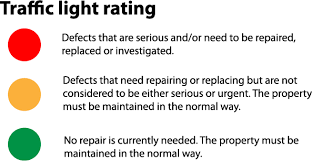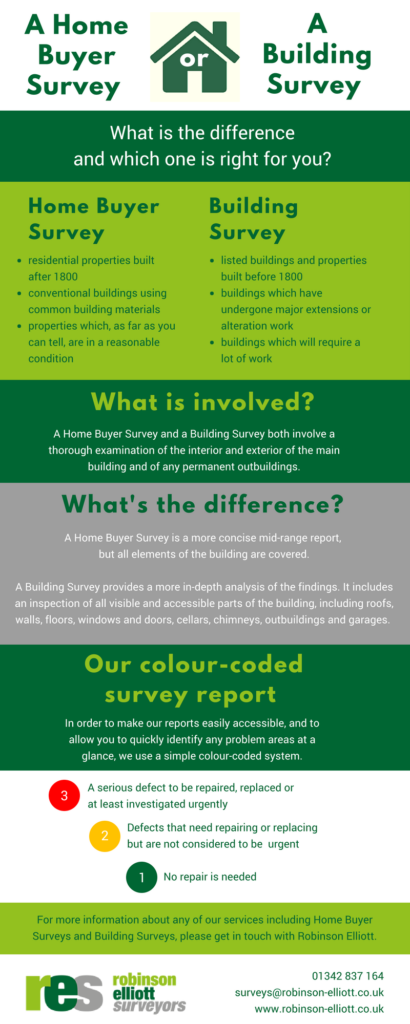What is the difference between a Building Survey and a Homebuyers Report?
 The difference between house surveys is important to understand for anyone buying property. You’re unlikely to spend as much in any other transaction, and making sure you have the right information about your new home is essential.
The difference between house surveys is important to understand for anyone buying property. You’re unlikely to spend as much in any other transaction, and making sure you have the right information about your new home is essential.
The core choice of surveys is between a Homebuyers Report and a Building Survey. What they cover is set out by RICS (Royal Institution of Chartered Surveyors), the professional body that regulates surveyors. RICS standards ensure that whatever type of survey you opt for, it will be carried out to the highest standard.
What are building surveys and homebuyers report called now?
RICS introduced new terminology in 2021 to help homebuyers understand the different types of survey available. Homebuyers Reports are now known as a Level 2 Home Surveys, and Building Surveys are Level 3 Home Surveys. There is no meaningful change in what is covered by each type of survey, but the format of the reports has now been standardised to provide consistency for consumers. RICS also renamed very basic surveys from a Condition Report to a Level 1 Home Survey.
RICS home surveys
As professional surveyors in Kent, Sussex, Surrey and the South-East, we are proud to have earned an excellent reputation for our work – see what our clients say . We meet, and often exceed, RICS standards of professional responsibility for all types of survey.
Level 1 surveys are the lowest cost option for homebuyers and involve a visual inspection of the general condition of the property. They provide general reassurance, but they don’t give any advice on any repairs that should be undertaken.
Homebuyers Reports, or Level 2 surveys, are based on a significantly more detailed inspection of the property, both inside and outside. It covers windows, lofts, exposed floors, services, permanent outbuildings and grounds. The scope of the survey does not include moving heavy furniture, lifting carpets or removing panels or hatches. We will also report on repair and maintenance issues. We can also add on a valuation report for Level 2 surveys.
Building Surveys, or Level 3 surveys, are still more thorough and complete. The detailed inspection will involve uncovering floors and walls to find hidden defects, as well as examining roofs, cellars and all other parts of the building wherever access is possible. The survey will also tell you about repairs and maintenance required, and any possible risks to anyone at the property.
Which type of survey should I choose?
The survey you choose should be based on the type of property you are buying. Generally speaking, the newer and smaller the building, the less detail is required. For larger, older buildings, you need more information to understand any concerns about the building
At Robinson Elliott, we recommend Level 1 surveys for recently built homes which are clearly in very good condition. For example, a Level 1 survey is likely to be all you need for a smaller, well-presented house in a recently built development.
As you step up to larger homes with higher price tags, we will usually suggest a Level 2 survey. The more thorough approach is very well suited to the majority of properties built after 1800, and which use conventional materials and building methods.
When you are buying an older or more expensive home, the potential for building faults increases, as does the possible costs for putting them right. That is why a detailed Level 3 survey is recommended.
What is the RICS home survey traffic light system?
As part of RICS’ drive to make surveys clearer and easier to understand, surveyors are now required to provide a green, amber or red flag to the items covered in all surveys. As a result, home buyers can understand the main parts of the survey at a glance. Although it’s an approach recently introduced by RICS, it’s one we have always taken at Robinson Elliott.
A green rating means that no repairs are needed and that basic maintenance only is required.
Amber ratings mean there are certain defects and further information will be included in the report. However, any issues with an amber flag are not considered serious or urgent.
A red rating is used for major defects which need to be fixed promptly. Failure to do so will result in increasingly significant and expensive problems with the building.
Any elements which are not included in the scope of the survey will be flagged NI (not inspected).

Do RICS surveys include a valuation?
We can produce an RICS standard market valuation report as an addition to a Level 2 or Level 3 survey. Generally, accurate market valuations will need the level of detail provided by these types of reports.
What type of survey helps you negotiate on price?
For buyers, a RICS Level 2 or Level 3 survey can be a useful factor in price negotiations. If work is needed on the property, or if there are maintenance issues which are not properly reflected in the selling price, it is perfectly reasonable to ask for a reduction.
While there is a cost involved in surveys and valuations, they can help to negotiate better deals on transactions, in addition to providing the reassurance that comes with knowing more about the property’s condition.
Is energy efficiency covered in surveys?
Whichever type of RICS survey you chose, the report will include the property’s EPC (Energy Performance Certificate) rating which runs from A (the most energy efficient) to G (the least efficient use of energy). EPC ratings are provided by accredited domestic energy assessors, and their findings are included in the survey.
Generally, a minimum standard of a C-rating is what most homebuyers will look for. Landlords are required to bring their properties up to this level before renting them out.
Home surveys at a glance
Our home surveys infographic provides an at-a-glance guide to different types of home survey.
We’ve put together this simple infographic to help you understand, see below or download here.







